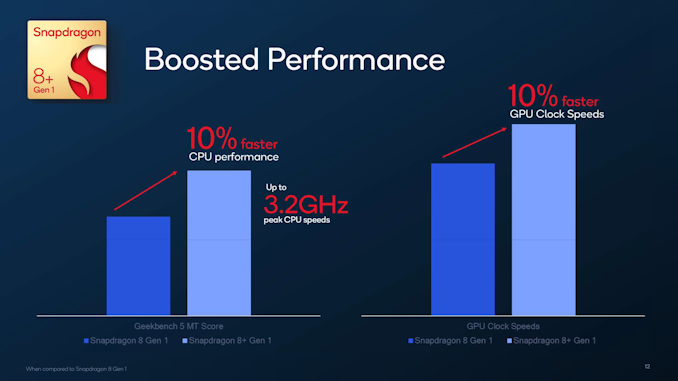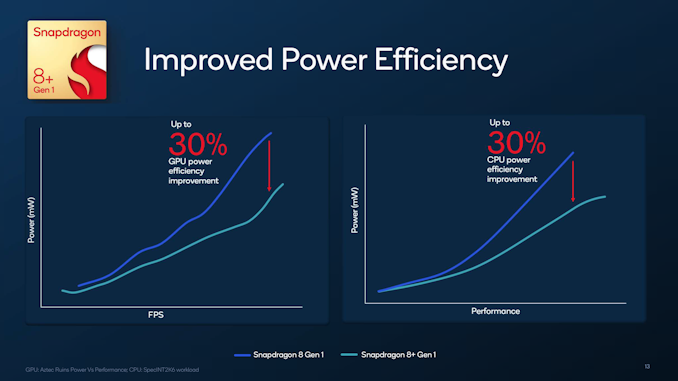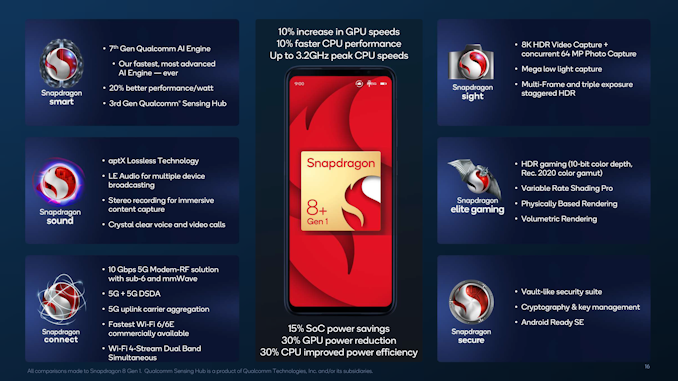Qualcomm Announces Snapdragon 8+ Gen 1: Moving to TSMC for More Speed, Lower Power
by Ryan Smith on May 20, 2022 8:00 AM EST
As the dark of the night rolls into China this evening, Qualcomm is hosting a mobile-focused product launch event they’re calling “Snapdragon Night”. Headlining the event is the announcement of the company’s new flagship SoC, the Snapdragon 8+ Gen 1. A mid-generation update to their flagship smartphone SoC, the Snapdragon 8 Gen 1, the 8+ Gen 1 follows Qualcomm’s annual tradition of releasing a refresh product to boost performance and to give partners something new to work with for the second half of the year. And for this year in particular, we’re looking at a very notable change in chips from Qualcomm.
Unlike previous generations where Qualcomm merely launched a faster speed bin of their existing silicon, for 2022 we have something more substantial to talk about. Qualcomm has switched up foundries entirely – moving from Samsung to TSMC – and as a result is rolling out a new die. Thanks to this, the Snapdragon 8+ Gen 1 Qualcomm is reaping something of a one-off manufacturing gain, allowing them to both dial up CPU and GPU performance while simultaneously cutting power consumption.
| Qualcomm Snapdragon 8 Gen 1 Flagship SoCs | |||
| SoC | Snapdragon 8+ Gen 1 | Snapdragon 8 Gen 1 | |
| CPU | 1x Cortex-X2 @ 3.2GHz 3x Cortex-A710 @ 2.8GHz 4x Cortex-A510 @ 2.0GHz 6MB sL3 |
1x Cortex-X2 @ 3.0GHz 3x Cortex-A710 @ 2.5GHz 4x Cortex-A510 @ 1.8GHz 6MB sL3 |
|
| GPU | Adreno (10% Higher Clockspeed) |
Adreno | |
| DSP / NPU | Hexagon | Hexagon | |
| Memory Controller |
4x 16-bit CH @ 3200MHz LPDDR5 / 51.2GB/s 4MB system level cache |
||
| ISP/Camera | Triple 18-bit Spectra ISP 1x 200MP or 108MP with ZSL or 64+36MP with ZSL or 3x 36MP with ZSL 8K HDR video & 64MP burst capture |
||
| Encode/ Decode |
8K30 / 4K120 10-bit H.265 Dolby Vision, HDR10+, HDR10, HLG 720p960 infinite recording |
||
| Integrated Modem | X65 integrated (5G NR Sub-6 + mmWave) DL = 10000 Mbps UL = 3000 Mbps |
||
| Mfc. Process | TSMC 4nm | Samsung 4nm | |
Quickly diving into the specifications, the new Snapdragon 8+ Gen 1 is essentially the original Snapdragon 8 Gen 1 ported over from Samsung’s 4nm line over to one of TSMC’s 4nm lines. Under more normal circumstances, this kind of a shift would likely be unremarkable – or at most, an amusing exercise in looking for edge cases – however for Qualcomm’s flagship SoC, the matter is more significant.
While official sources and statements on the quality of Samsung’s 4nm process are few and far between, unofficially, it’s become clear that Samsung’s 4nm process hasn’t lived up to expectations. This has caused a cascading impact on the chips made on the process node, leading to the original Snapdragon 8 Gen 1 developing an affinity for power consumption, and Samsung’s own Exynos 2200 not faring any better. Conversely, by all accounts TSMC’s N4 process is looking great, with the optically shrunk node building off of TSMC’s already successful and very performant 5nm technologies.
As a result of this performance gap between Samsung and TSMC’s 4nm nodes, Qualcomm is taking the unusual step of (essentially) porting their high-end SoC over to TSMC’s fab. Which, although not strictly necessary – Qualcomm carries a lot of momentum and the 8 Gen 1 has been selling well – is certainly a prudent move for the company. Qualcomm is facing especially stiff competition this generation from MediaTek, whose flagship-level Dimensity 9000 SoC was the lead product for TSMC’s 4nm node. And that leaves MediaTek with a distinct advantage against the original 8 Gen 1, one that Qualcomm would be very happy to nullify.
Ultimately, the switch in fabs is giving Qualcomm a chance to improve upon the original 8 Gen 1 from both ends of the spectrum, resulting in the Snapdragon 8+ Gen 1. On the performance front, TSMC’s node affords them an easy opportunity to increase CPU and GPU clockspeeds for more performance. The prime Cortex-X2 core is now clocked 7% higher, at 3.2GHz, and meanwhile the A710 and A510 clusters have seen their clockspeeds dialed up even more significantly, by around 12% each. Now even the slowest A510 cores can run at 2GHz. GPU clockspeeds have also been similarly increased, and while Qualcomm does not disclose specific clockspeeds there, they have confirmed that the 8+ Gen 1’s Adreno GPU block is clocked 10% higher than the original 8 Gen 1.
But, if anything, the bulk of Qualcomm’s gains from the switch in manufacturing nodes are being invested in cutting power consumption. Something of a sore point with the 8 Gen 1, TSMC’s better 4nm process means that Qualcomm is seeing much lower power consumption across their SoC at iso-frequency.
Officially, Qualcomm is claiming a 30% improvement in both GPU and CPU power efficiency. Though as mentioned before, this is at iso-frequency and doesn’t take into account the higher peak clockspeeds of the 8+ Gen 1. Consequently, the real-world power savings aren’t going to be quite as great on a peak-to-peak basis, but according to Qualcomm the power savings are still significant. Overall, the company is touting a 15% reduction in SoC power usage under “practical usage patterns” versus the original 8 Gen 1, which in turn should lead to improved battery lifetimes in handsets that adopt the new SoC.
Past that, the official specifications for the 8+ Gen 1 do not reflect any material changes to the SoC’s configuration versus the original chip. So we’re still looking at the same integrated X65 5G modem, the same Spectra ISP, and the same video encode/decode blocks (sorry, gang, still no AV1 support!). So, despite assembling a new die for their mid-generation refresh product this year, there aren’t any new features to speak of with the 8+ Gen 1.
As for SoC performance, officially Qualcomm is claiming 10% improved GPU and CPU performance, owing to those aforementioned clockspeed increases. While we weren’t able to attend a benchmarking session that Qualcomm held last week, the Performance Mode figures being released by the company are roughly in-line with these claims. Qualcomm’s Geekbench 5 results are several percent higher than what we benchmarked back in December at the 8 Gen 1 launch event, though it’s notable that they didn’t achieve meaningfully higher scores in PCMark. GPU performance figures are similarly mixed, with some of Qualcomm’s official results coming very close to our original 8 Gen 1 results, but I’m reluctant to read too much into them given how much if a difference peak versus sustained testing makes in GPU results. As always, the final word will need to come down to independent, third-party testing, though at face value nothing Qualcomm claims is unreasonable given the clockspeed improvements and the thermal headroom gained from the switch to TSMC.
Finally, as for consumers, they’ll be able to get their first look at Snapdragon 8+ Gen 1 devices in Q3 of this year. According to Qualcomm, many of the usual suspects have signed on to release phones based on the new SoC, including Asus, Motorola, OnePlus, Honor, and Xiaomi.













51 Comments
View All Comments
Archer_Legend - Friday, May 20, 2022 - link
It would be nice to have a deep dive review of the Exynos 2200, the Snapdragon 8 gen 1 and the Snapdragon 8 gen 1 plus and the Dimensity 9000.Le Geek - Friday, May 20, 2022 - link
I second this, we didn't have such an article this year.Archer_Legend - Friday, May 20, 2022 - link
I know, and those deep dives where really unique, you cannot find such articles on other sites, I hope they start working on it.ballsystemlord - Friday, May 20, 2022 - link
I agree. Go for the deep dive!Kangal - Sunday, May 22, 2022 - link
Does AnandTech have the staff and expertise anymore for those deep-dives?yeeeeman - Sunday, May 22, 2022 - link
Seems like they are in a bit of a bad momentCellar Door - Friday, May 20, 2022 - link
There won't be one - Andrei Frumusanu, who did all those excellent reviews left Anandtech.garblah - Friday, May 20, 2022 - link
Maybe it won't be as in depth and knowledgeable as what Andrei would have done, but hopefully they take a stab at it anyway.DeathArrow - Saturday, May 21, 2022 - link
They just need to hire someone competent enough to write that kind of articles.Wereweeb - Saturday, May 21, 2022 - link
This website is probably in it's current state precisely because it's owners won't hire the necessary amount of competent people. I assume that the business model of writing quality articles and cashing in through ads isn't very good for the bloodsuckers (I.e. investors). Clickbait articles have a much better return on investment.